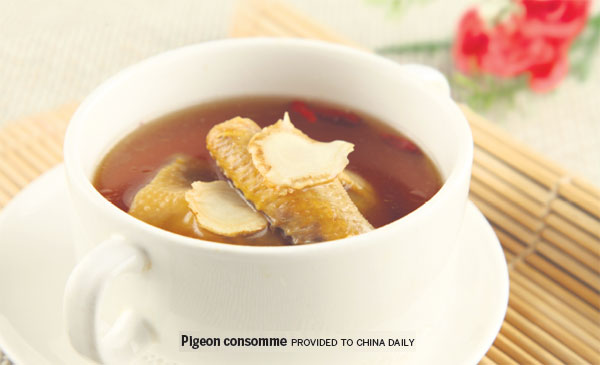Succulent pigeon on the table
Editor's note: Traditional and fusion cooking styles, regional and international ingredients and a new awareness of healthy eating are all factors contributing to an exciting time for Chinese cuisine. We explore the possibilities.
If you slowly stroll through the old Beijing alleyways, you can sometimes hear a whistling high overhead. Look up, and you may see a flock of pigeons whirling, flying in synchronized circles as they swoop above the hutong. There's the source of the whistling.
These are pet homing pigeons, and their owners often attach little bamboo whistles to their legs so they make music while in flight.

They are often entered in competitions, and a good homing pigeon is as valuable as a pedigreed canine, if not more so.
My grandfather, too, had a dovecote in the backyard, and his birds would perch on the ledges, grooming their gray feathers and sunning their metallic blue and green collars. Occasionally, they would be released so they could fly for a few hours in freedom.
They always came home. Grandfather gave them clean nesting cubicles, and the best imported maize. He would name them, too, but he never forgot these were birds reared for their meat, squabs and eggs.
As a child, I was asthmatic, and grandfather had learned that squab soup could help prevent the wheezing. Baby pigeons were harvested and steamed with Chinese herbs in soup.
Thankfully, I was too young then to associate this delicious broth with the downy pigeon chicks.
Pigeon eggs, hard-boiled, were also dipped into crushed rock salt. Unlike chicken eggs, pigeon eggs stayed translucent even when fully cooked, their whites retaining a slight jelly wobble.
Perhaps it is this novel quality that makes them one of the ingredients in that decadent, luxuriously tasty Buddha Jumps Over the Wall, the Fujianese soup-stew that is the highlight of so many Chinese banquets.
The gourmets also believe pigeon eggs are a lot more nutritious than chicken or duck eggs. For that reason, they cost several times more, if and when you can get them.
Neighboring Guangdong province loves its pigeons as well, and one of the region's most well-known signature dishes is Cantonese roast pigeon.
In Hong Kong's New Territories, a very famous hillside restaurant has built its entire menu around this little bird, and it is probably the world's most famous pigeon restaurant, according to its collection of tourist reviews.
Lung Wah Restaurant started life as a hotel in the 1950s and was immortalized in many of the old Cantonese movies starring grandma heartthrobs such as Patrick Tze Yin. Kungfu legend Bruce Lee also reportedly stayed at the hotel before it closed its rooms in the mid-1980s.
What stayed behind was the restaurant and its famous roast pigeons. It is still doing a roaring business to this day, and until the SARS scare in 2003, it had a pigeon farm on the premises.
The roast pigeon is marinated thoroughly and deep-fried to perfection. The gaminess of the bird is masked by a recipe of herbs that includes musk. It is a secret blend that is jealously guarded by the family, of course.
The deep-fried bird has a papery skin that is crisp and brittle, while the meat retains all its succulence. And, surprisingly, it is not at all fatty.
Pigeon is a lean bird with very little subcutaneous fat, and that is another reason why it cooks so well.
Another famous pigeon dish is a soup made from its minced meat, steamed in a bamboo cup. Stock made from the bones helps the soup take shape. The result is an intensely flavorful consomme that captures the essence of the bird.
Pigeon floss in lettuce wrap is another signature dish. Finely minced pigeon meat is stir-fried with tiny cubes of bamboo shoots, carrots, beans and mushrooms.
Crisp iceberg lettuce cups become edible receptacles. This dish is ideal for those who dislike having to navigate tiny bones.
Pigeon eggs are soft-cooked before being deep-fried and served in a crisp and savory string potato nest. The result is a beautifully textured egg with a slightly chewy golden crust, tender egg white and a still-liquid yolk.
Another way to cook the eggs is to bake them in rock salt.
Pigeons are regarded as pests in many urban centers, where those who dislike them regard them as rodents on wings.
In Singapore's housing estates, for example, the pigeon population has expanded prodigiously - so much so that there are signs everywhere discouraging people from feeding them because they build flimsy nests on window ledges and on top of air-conditioning units.
But in a country like China where pigeon is regarded as a tasty meat, there does not seem to be any problem. Perhaps it's time to look at solutions from a new angle.
paulined@chinadaily.com.cn
Recipe
Soy-sauce braised pigeon
4 pigeons, dressed
1 cup top quality soy sauce
2 cups water
4 tablespoons rose-scented Chinese wine, Meiguilu
50g rock sugar, crushed
2-3 slices galangal
1-2 sticks cinnamon
1-2 star anise pods
6 shallots, roughly chopped
1-2 cloves garlic, roughly chopped
Add a little oil to a pan and fry the chopped shallots and garlic till fragrant. Add cinnamon, star anise, galangal slices. Fry till the cinnamon releases its aroma.
Add the soy sauce, sugar and water and bring the mixture to a boil. Add the rose-scented wine.
When the braising liquid is bubbling merrily, lower the cleaned pigeons into the mixture. After five minutes, cover the pot with a tightfitting lid and switch off the heat. Do not open the lid, but allow the whole pot to cool. The residual heat will complete the cooking, and the pigeons will be soft and tender.
Chill, quarter and serve.
(You can substitute with spring chickens.)
Pigeon consomme
2 pigeons
1-2 slices young ginger
1 teaspoon ginger juice
1 teaspoon quality Chinese wine, huadiao
1-2 stalks spring onions
Salt and pepper to taste
First, get as much meat off the pigeons as you can, scraping the bones clean. Set aside the meat.
Crush the pigeon carcass and chop into smaller sections.
Heat up a liter of water and add the ginger slices and spring onions. Add the pigeon bones and bring to a boil. Simmer till broth is flavorful.
While the stock is brewing, finely mince the pigeon meat, sprinkling the ginger juice over.
Divide the minced pigeon into four.
Place each portion into a Chinese rice bowl (or large bamboo cup if you can get them). Top with the cooled pigeon stock and seal the top with foil. Steam the soup over high heat for 15 minutes.
Season with salt and pepper.
Pigeon eggs in rock salt
10 pigeon eggs
1 kg rough rock salt
Fry the rock salt in a heavy-bottomed pan until it is too hot to touch. Make a well in the middle and add the pigeon eggs. Cover the eggs again with the salt. Keep the wok on medium heat for 10 minutes.
Switch off the heat and let the salt cool.
Place the cooked eggs in a nest of lettuce and serve.


















